There’s often a question about Philippines geography: Is Batanes part of Luzon? Batanes is geographically close to Luzon, but the answer is not simple.
Batanes is an archipelagic province in the Philippines’ far north. It belongs to the Cagayan Valley region administratively. But, including it as part of Luzon is complex.
So, does Batanes count as part of Luzon? Let’s look closer at Batanes and Luzon’s link and discover what makes this province so fascinating.
Key Takeaways:
- Batanes is an archipelagic province located in the northernmost part of the Philippines.
- While geographically close to Luzon, it is not technically part of the main island.
- However, Batanes is connected to Luzon through its proximity and cultural ties.
- The unique geography and rich history of Batanes make it a must-visit destination.
- The Ivatan people preserve their traditional way of life, making Batanes a place of cultural significance.
Location of Batanes in the Philippines
Batanes is a beautiful place in the northern part of the Philippines. Known for its amazing views and special culture, it sits about 162 kilometers north of Luzon. It’s between the Balintang Channel and the Babuyan Islands. This puts it around 190 kilometers south of Taiwan, separated by the Bashi Channel.
This unique spot in Luzon is close to Taiwan too. This mix creates a special blend of culture and traditions. In Batanes, visitors see stunning landscapes and meet the welcoming Ivatan people.
The image above shows Batanes’ beauty. It highlights its special spot in the Philippines and its link to Luzon.
Geographical Features of Batanes
Batanes is a group of 10 islands, with Batan, Itbayat, and Sabtang being where people live. It covers about 229 square kilometers, and it has a big sea area of 4,500 square kilometers. This area shows many different types of nature for visitors to see.
You’ll find beautiful views here, like green hills, tall cliffs, and lovely sea sights. Nature lovers will enjoy walking, taking pictures, and seeing untouched places. The wild beaches and clean coasts are great for chilling and exploring.
The waters around Batanes are full of sea life, which is great for those who like snorkeling or diving. When you dive into the sea, you will see colorful corals, special sea creatures, and interesting rocks.
Besides its beauty, Batanes has rich soil for farming. People here grow sweet potatoes, garlic, and other crops. The good soil and cool weather help farming do well in this area.
All in all, Batanes is amazing for anyone who loves nature. You can walk through hills, enjoy the sea coasts, or see amazing sea life. Visiting Batanes is an experience you’ll never forget.
Historical Background of Batanes
The province of Batanes holds a key place in Luzon’s history, known for its heritage and strategic spot. The Ivatan people, original settlers, came to the islands about 4,000 years ago. Their culture deeply influences Batanes.
Before the Spanish took over, Batanes was important on the Maritime Jade Road. It was a center for trade and interaction. This shows Batanes’ role in Luzon’s past.
The ancestors of the Ivatan people, the indigenous inhabitants of Batanes, migrated to the islands around 4,000 years ago. The province has a rich history, being a major site for the Maritime Jade Road during the prehistoric period.
In 1783, Batanes joined the Philippines when Spain claimed it. It became vital for stopping British influence in the region. The Spanish improved governance and built infrastructure here.
Batanes always stayed close to Luzon, keeping its unique traditions alive. Its history is part of Luzon’s story, showing both connection and uniqueness.
The Significance of Batanes in Luzon
Batanes is crucial to understanding Luzon’s history. Its location and cultural bonds add much to Luzon’s story.
As a trade center on the Maritime Jade Road, Batanes helped Luzon connect with Southeast Asia. This trade network made the region culturally rich.
During Spanish times, Batanes protected Luzon from British invasions. Its strategic position safeguarded Luzon’s lands. This shows Batanes’ importance in defense.
Batanes’s history enriches Luzon’s story, adding to the mix of cultures and traditions. It shows how Luzon’s provinces are connected yet unique.
To sum up, Batanes has a special role in Luzon’s history. From its ancient trade roots to defending against invasions, Batanes has marked Luzon’s cultural and historical landscape.
Spanish Colonial Era in Batanes
During the Spanish colonial era, Batanes was part of the Provincia de Cagayan. The Spanish built towns like Basco and Ivana. They also brought in roads, ports, bridges, and churches. The local architecture and traditions still reflect Spanish culture.
The Spanish left a big mark on Batanes. They created towns and brought their language, religion, and customs. Churches built during this time still stand, showing the Spanish period. These churches have thick stone walls and bell towers, showing Spanish craftsmanship.
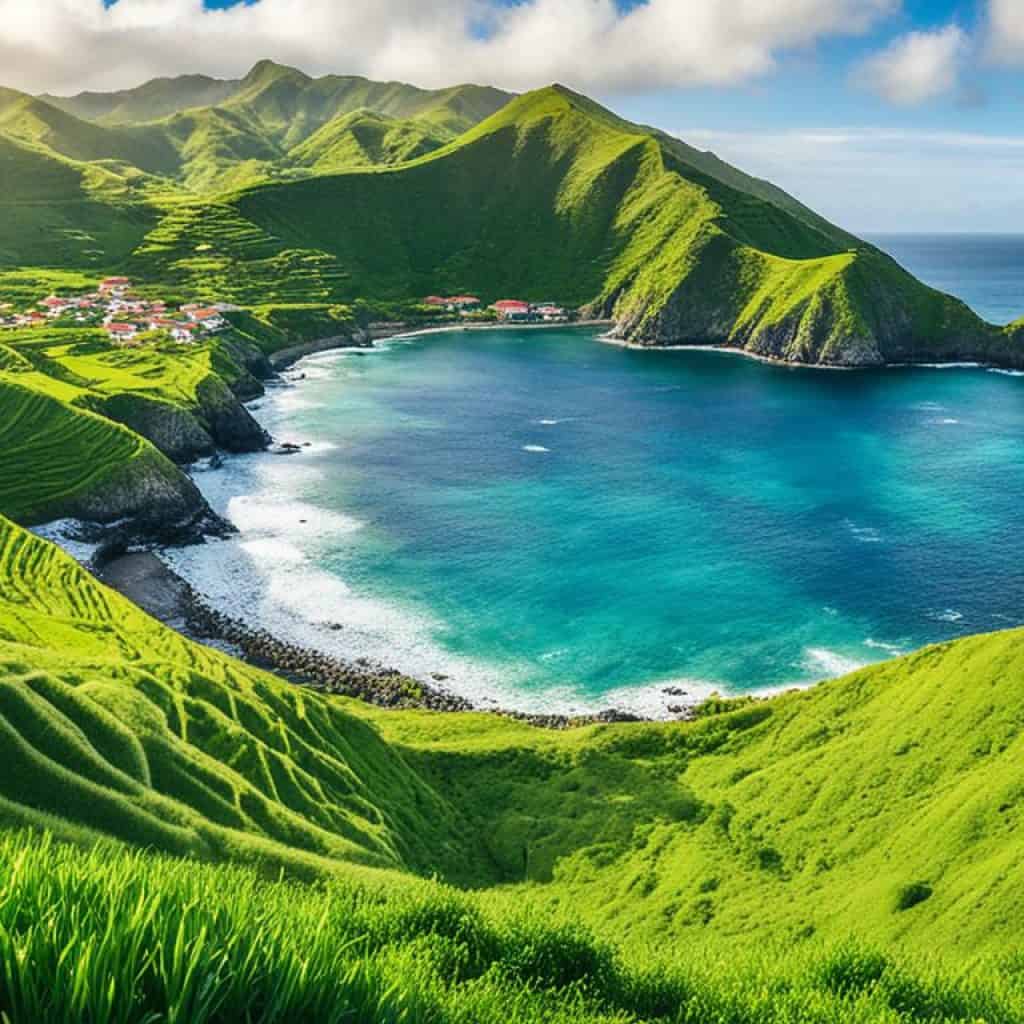
“The Spanish colonial era in Batanes played a crucial role in shaping the province’s cultural landscape. The introduction of Spanish infrastructure and traditions enriched the local heritage, creating a fusion of Ivatan and Spanish influences.”
Spanish colonization introduced Catholicism to Batanes, now the main religion. The many churches across the province are both religious and cultural landmarks.
Spanish Heritage Sites in Batanes
Exploring Batanes and nearby Luzon areas lets you see unique Spanish heritage sites. Some key sites include:
| Spanish Heritage Sites | Location |
|---|---|
| San Carlos Borromeo Church | Basco, Batan Island |
| Santo Domingo Church | Uyugan, Batan Island |
| San Jose de Ivana Church | Ivana, Batan Island |
| Santa Rosa de Lima Church | Mahatao, Batan Island |
Visiting these sites shows the historical and architectural importance of Batanes. These well-preserved structures highlight Batanes’ colonial history.
American Colonial Period and Japanese Occupation
In 1907, Batanes was part of Cagayan as a sub-province. By 1909, it became an independent province. But World War II broke out, disturbing its peace.
Japan took over the Philippines quickly, and Batanes was an early target. This was due to its strategic location.
Exploring Batanes and nearby Luzon areas became a war zone. Filipino-American forces fought the Japanese there. The locals faced tough times but stayed strong.
“The people of Batanes displayed remarkable resilience during the Japanese occupation. Despite the challenges they faced, they held on to their cultural heritage and supported the resistance efforts.” – Local Historian
After years under Japanese control, Batanes was liberated by Filipino and American soldiers. This liberation was the start of recovery after the war.
The Batanes community showed incredible strength during these hard times. They preserved their identity and cultural heritage.
| Year | Event |
|---|---|
| 1907 | Batanes becomes a sub-province of Cagayan |
| 1909 | Batanes gains independence as a province |
| 1942 | Japanese occupation begins |
| 1945 | Batanes liberated by Filipino and American troops |
Batanes in the Post-War Era
After the war, Batanes changed a lot. It became a regular province and saw its municipalities grow. People here started to understand their role in the Philippines better. They celebrated Ivatan culture more.
Now, Batanes is a top spot for tourists. They come for the stunning nature and rich culture.
The Development of Batanes Province
Once the war ended, Batanes got a new status. Its towns developed a lot. This led to better roads and services for those visiting Batanes and nearby Luzon.
Celebrating Ivatan Culture
The end of the war also meant a boost for Ivatan culture. Locals celebrate their traditions with pride. Visitors can learn a lot about Ivatan life and customs.
Batanes: A Haven for Nature Enthusiasts
Batanes is perfect for those who love nature. It has amazing hills, cliffs, and sea views. People can hike, see wildlife, and enjoy the outdoors here and in Luzon.
| Reasons to Explore Batanes and Nearby Luzon Areas | Benefits |
|---|---|
| 1. Expansive natural beauty | A chance to marvel at the picturesque landscapes of Batanes and nearby Luzon areas, creating unforgettable memories. |
| 2. Cultural immersion | Opportunities to engage with the local Ivatan culture, fostering understanding and appreciation of the Luzon region. |
| 3. Outdoor activities | Thrilling adventures such as hiking, biking, and beach hopping in the stunning surroundings of Batanes and its vicinity. |
| 4. Unique experiences | The chance to witness the post-war transformation of Batanes, witnessing the resilience and growth of this remarkable province. |
Looking for nature, culture, or unique experiences? Exploring Batanes and Luzon areas is a great choice. You’ll find breathtaking places and learn a lot.
Geography of Batan Island
Batan Island is the largest in Batanes province. It has a fascinating geography that draws people in. The island looks like a dumbbell and has mountains like Mount Iraya and Mount Matarem.
These mountains make the island hilly with dramatic coasts. It’s truly stunning.
Traveling around Batan Island is easy because of land bridges. You’ll see incredible sea views, green hills, and beautiful towns.
The Land of Volcanoes and Scenic Vistas
Mount Iraya is a sleeping giant on Batan Island. It welcomes hikers with its green slopes. From the top, you see amazing sunrises and the whole island.
Volcanic activities made the land fertile. This helps many plants and animals to live here.
Batan Island’s volcanic landscapes and coastal views make it a paradise for nature enthusiasts and photographers, guaranteeing unforgettable experiences and stunning imagery.
Besides volcanoes, Batan has other beautiful places. The Vayang Rolling Hills are where green slopes meet the ocean. Then, there’s Mahatao Church, with its lovely stone walls.
An Idyllic Escape
Valugan Boulder Beach is peaceful with unique rocks and waves. It shows the island’s volcanic past with big stones along the shore.
In Batan Island’s towns, you’ll meet friendly locals. Basco is the capital. It’s full of life, local dishes, and crafts.
Discover the Magic of Batan Island
Batan Island offers unique geography and stunning views. It’s perfect for those who love volcanoes, coasts, or cultural heritage. Batan Island invites you to uncover its beauty.
Sabtang Island and Other Inhabited Islands
Sabtang Island lies southwest of Batan Island in Batanes. It’s known for breathtaking landscapes and Ivatan stone houses. This island offers an authentic experience for those exploring Batanes and Luzon.
Rolling hills, secluded beaches, and charming villages welcome you here. They showcase the Ivatan people’s rich culture. Nature lovers will adore the sea views, cliffs, and green spaces.
The Ivatan stone houses are a big highlight. Made from limestone and cogon grass, they’ve stood strong over time. They show the Ivatan’s skill in creating durable homes.
Batanes also has other islands worth seeing. Itbayat has amazing cliffs and caves for the adventurous. Uyugan, Ivana, and Mahatao offer calm beaches, historical sites, and a peek into local life.
From Sabtang’s architecture to Itbayat’s landscapes and the culture of Uyugan, Ivana, and Mahatao, you’ll get a real and memorable experience. These places show the beauty and uniqueness of Luzon Island and Batanes.
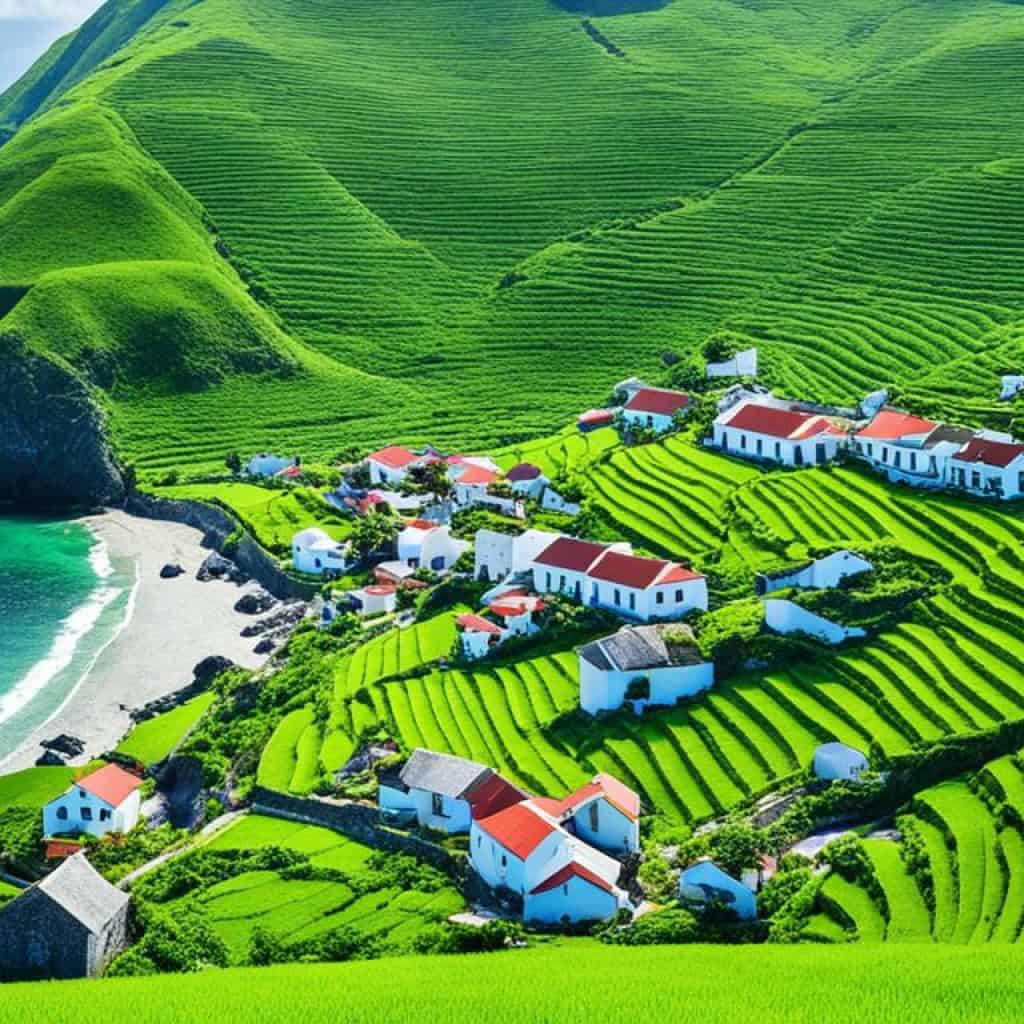
| Island | Location | Attractions |
|---|---|---|
| Sabtang | Southwest of Batan Island | Traditional Ivatan stone houses, stunning landscapes |
| Itbayat | Farthest from the mainland | Dramatic cliffs, caves, untouched beauty |
| Uyugan | Across Batan Island | Serene beaches, historical landmarks |
| Ivana | Across Batan Island | Local culture, traditional villages |
| Mahatao | Across Batan Island | Rural charm, scenic landscapes |
Unique Culture and Architecture of Batanes
Batanes is known for its rich history and special geography. This region stands out in the Philippines. The Ivatan people have lived here for centuries. They keep their traditional lifestyle alive, showing a strong cultural identity.
The architecture in Batanes is very special. The stone houses, called “honesty houses,” show the Ivatan people’s bond with nature and weather. These strong and beautiful homes symbolize the Ivatan’s resilience. They have become a key symbol of Batanes, showing the province’s strength and spirit.
The Ivatan language and customs
The Ivatan language holds a dear place in Batanes. It helps keep traditions and stories alive. Even with modern influences, this language is a key part of local life. It links language closely with culture.
Ivatan traditions also add to the province’s rich culture. Festivals, celebrations, and rituals let Ivatans share their heritage with visitors. It’s an invite to experience the unique culture of Batanes.
“The unique culture and architecture of Batanes are not mere tourist attractions; they are a living tribute to the Ivatan people’s resilience and beauty.”
The significance of Batanes in Luzon
Batanes might seem different from Luzon, but it’s very important to the region. It connects cultures, landscapes, and architectural wonders. For both locals and visitors, Batanes shows the diverse beauty of the Philippines.
Batanes shares its culture and architecture with Luzon, making it a valuable place. Exploring Batanes lets you see how different areas in Luzon connect. It highlights Batanes’ strong relationship with Luzon.
| Points of Interest | Highlights |
|---|---|
| Stone Houses | Iconic structures that symbolize the resilience of the Ivatan people |
| Festivals and Rituals | Vibrant celebrations showcasing Ivatan customs and traditions |
| Archaeological Sites | Historic locations offering insights into the prehistoric era in the Philippines |
| Rolling Hills and Coastal Views | Breathtaking scenery that showcases the natural beauty of the province |
Tourism in Batanes
Batanes is now a top tourist spot, thanks to its beautiful landscapes and rich culture. It’s near Luzon. Visitors come to see its unique buildings, enjoy the views, live the Ivatan lifestyle, and try outdoor fun.
Visiting Batanes and Luzon enriches travelers’ trips. Its closeness to Luzon makes it a great spot to include in travel plans.
“Batanes is a hidden gem waiting to be discovered, offering breathtaking natural beauty and a glimpse into the rich culture and history of the Ivatan people.”
In Batanes, the unique architecture is a big draw. Ivatan stone houses are built strong to face tough weather. These houses show off Batanes’ history and culture. They have thick stone walls and roofs made of cogon grass.
For those who love nature, Batanes is full of beautiful sights. There are hills and cliffs to hike, and coastal paths for biking. It also has untouched beaches for relaxing and exploring.
Batanes and Luzon offer an authentic Philippine adventure. Its landscapes and culture near Luzon make it a place travelers must see.
Population and Governance of Batanes
Batanes is in the Luzon region of the Philippines, with around 18,831 residents in 2020. It’s the northernmost province in the country. It has elected leaders like a governor and vice-governor who guide its growth and management.
Batanes has six municipalities, each offering unique experiences. Basco, the capital, is the biggest and serves as the heart of business, government, and trade. It’s known for stunning scenery and rich culture. This draws tourists looking for a memorable journey in this beautiful part of the Philippines.
Table: Municipality and Population in Batanes
| Municipality | Population |
|---|---|
| Basco | 8,579 |
| Mahatao | 1,653 |
| Ivana | 1,653 |
| Uyugan | 1,472 |
| Sabtang | 1,621 |
| Itbayat | 3,253 |
The local government in Batanes works hard to keep its natural and cultural beauty intact. They safeguard the unique ecosystems and push for eco-friendly tourism. The goal is to let future travelers see and enjoy Batanes’ splendors. Balancing development with preservation, Batanes aims to stay captivating. It provides a balanced and vibrant place for both locals and tourists.
Language and Religion in Batanes
Batanes is a place with many languages. This shows the rich culture of the area. Ivatan, Itbayaten, Isamurongen, Ilocano, Tagalog, and English are mainly spoken here.
In Batanes, religion is very important. Most people follow the Catholic faith. This faith shapes their life, culture, and traditions.
Being part of the same religion brings people together. It makes the community of Batanes strong and united.
The Linguistic Diversity of Batanes
Batanes is known for its variety of languages. Ivatan, Itbayaten, Isamurongen, Ilocano, Tagalog, and English are commonly used.
Ivatan is the most spoken language on Batan and Sabtang islands. It is unique compared to other Philippine languages. Itbayaten is mainly spoken on Itbayat Island. Isamurongen is used in Mahatao and Uyugan.
Apart from local languages, many people in Batanes speak Ilocano, Tagalog, and English. English is especially common in tourist areas.
Religion in Batanes: The Influence of Catholicism
“The faith of the Ivatan people plays a vital role in shaping their daily lives, cultural practices, and traditions.”
— Juan dela Cruz, Mayor of Basco Municipality
Catholicism is the main religion in Batanes. It came with Spanish missionaries during the colonial era. Since then, it has become a core part of the culture.
Catholicism affects daily life in Batanes in many ways. People go to Mass, celebrate festivals, and decorate with religious symbols. Churches like Ivana Church and Basco Cathedral show the strong beliefs of the community.
The Catholic faith brings unity and shared values to Batanes. It is key to the identity and community spirit of the province.
Conservation and Preservation Efforts in Batanes
Batanes, relatively close to Luzon, is keen on protecting its natural and cultural treasures. It takes steps to keep its unique ecosystems sustainable and encourage responsible tourism.
“To preserve our environment is essential for our heritage and Batanes’s future. We aim to balance exploration and the protection of our natural beauty,” said the Governor of Batanes.
– Governor of Batanes
To keep its landscapes untouched, Batanes has created protected areas. These help conserve the province’s diverse plants, animals, and beautiful scenery.
The province promotes tourism that doesn’t harm the environment. Tourists are asked to dispose of waste properly, respect wildlife areas, and join eco-friendly activities.
Batanes works hard to teach both locals and visitors about protecting the environment. It runs campaigns and programs for better understanding of its ecosystems and those in Luzon.
Conservation and Preservation Initiatives:
- Creating marine protected areas to save coral reefs and marine life
- Reforestation efforts to restore and safeguard forests
- Implementing sustainable waste management
- Working with locals for responsible fishing
- Keeping cultural heritage sites like Ivatan stone houses intact
| Conservation and Preservation Efforts in Batanes | Description |
|---|---|
| Protected Landscapes and Seascapes | Legally protected areas in Batanes to maintain their beauty and diverse life. |
| Sustainable Tourism Practices | Plans and rules to make tourism eco-friendly. |
| Educational Campaigns | Projects to make locals and tourists aware of the need for environmental care. |
| Marine Protected Areas | Areas in Batanes waters with controlled activities to safeguard marine ecosystems. |
| Reforestation Projects | Initiatives for planting trees and conservation to restore forests. |
Batanes prioritizes conservation and preservation, hoping future generations will explore its natural beauty and learn about its connection to Luzon.
Conclusion
Batanes may not be a part of Luzon, but it’s closely linked to it. It sits 162 kilometers north of Luzon. This makes it a special part of the northern Philippines. Batanes is known for its beautiful sceneries, rich history, and vibrant culture.
When people visit Batanes, they see its rolling hills, rocky cliffs, and lovely coastal views. The Ivatan people’s stone houses and traditions add to the province’s charm. For the Ivatan community, Batanes is a jewel.
Seeing Batanes shows the beauty and variety of the Philippines’ islands. You can hike stunning landscapes, learn local ways, or enjoy the Ivatans’ hospitality. Batanes is a must-visit in the Philippines. It shows a unique link with Luzon.
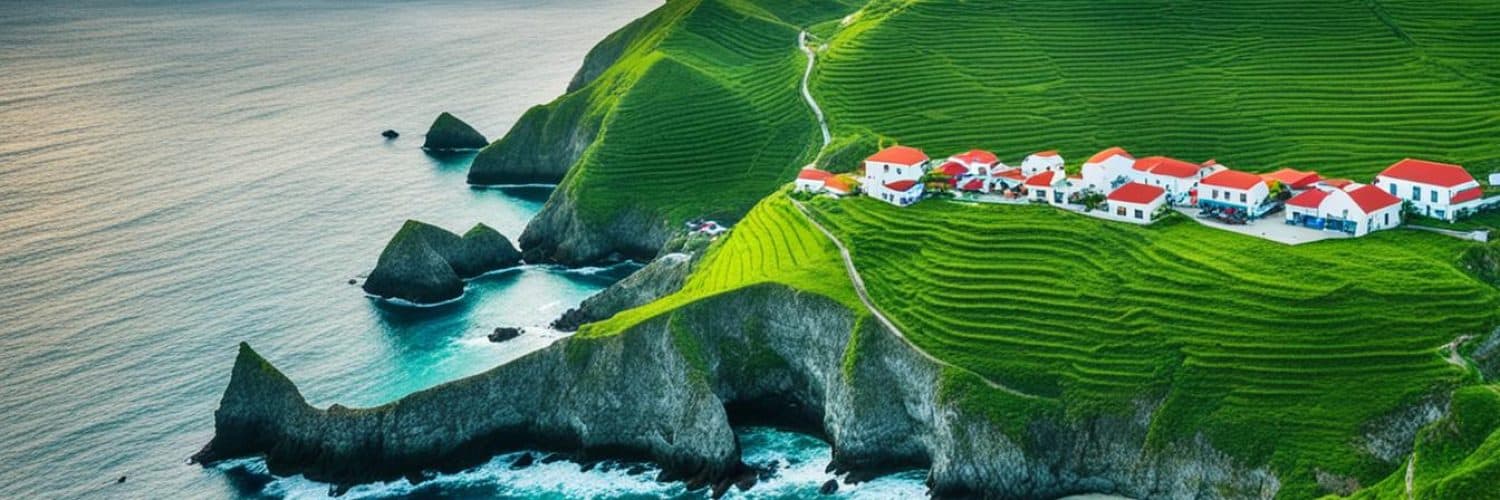
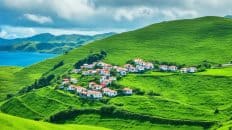

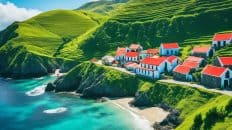










Add comment